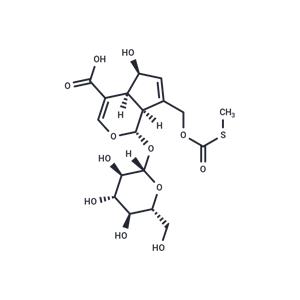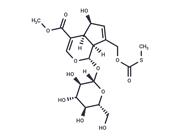| Name | Paederosidic acid |
| Description | Paederosidic acid has significant anti-tumor, anticonvulsant and sedative effects. Paederosidic acid increases brain gamma-aminobutyric acid and decreases glutamic acid in the brain, and it up-regulates expressions of GAD 65, may be a promising future therapeutic agent for treatment of epilepsy. |
| Cell Research | The anti-proliferative effects of PA on A549 cells were evaluated by MTT method and the IC50 values were calculated. Furthermore, the PA-induced apoptosis in A549 cells was determined by fluorescence microscope via staining with DAPI and by flow cytometer via staining with FITC conjugated Annexin V/PI. The expression of apoptosis-related or signaling proteins was investigated by Western blotting[1] |
| Animal Research | Anticonvulsant activities of paederosidic acid were evaluated by maximal electroshock and pentylenetetrazole-induced seizures in male mice. Then, pentobarbital sodium-induced sleeping time and locomotor activity tests in mice were used to evaluate the sedative effects of paederosidic acid. Finally, the mechanism of paederosidic acid was explored by evaluating the contents of Glu and GABA in the brain, and Western blot was used to measure GAD65 expression in the mouse brain[2]. |
| In vitro | Paederosidic acid(PA) showed significant anti-tumor activity on lung cancer in vitro; the mechanisms were involved in inducing mitochondria-mediated apoptosis via up-regulation of caspase-3, caspase-8, caspase-9, Bid, Bax, down-regulation of Bcl-2 and stimulating the release of Cyto-C from mitochondria.JNK phosphorylation levels significantly increased concomitantly with decrease in Akt phosphorylation after treatment with PA in A549 cells. However, JNK siRNA-transfected cells diminished PA-induced caspase-3, 8 and 9, Bid and Bax activaton while enhanced the Bcl-2 activation. PA-induced JNK activation played an important functional role in apoptosis[1]. |
| In vivo | Anticonvulsant and sedative effects of paederosidic acid isolated from Paederia scandens (Lour.) Merrill. in mice and rats.Paederosidic acid (5, 10, 20, and 40 mg/kg, ip) had significant anticonvulsant and sedative effects. paederosidic acid increased brain gamma-aminobutyric acid and decreased glutamic acid in the brain, and it up-regulated expressions of GAD 65. Paederosidic acid may be a promising future therapeutic agent for treatment of epilepsy[2]. |
| Storage | Powder: -20°C for 3 years | In solvent: -80°C for 1 year | Shipping with blue ice. |
| Solubility Information | DMSO : 55 mg/mL (118.42 mM)
|
| Keywords | cancer | A549 | Apoptosis | inhibit | Lung | Paederosidic acid | acid | Paederosidic | Inhibitor |
| Inhibitors Related | Stavudine | 5-Fluorouracil | Myricetin | Meclizine dihydrochloride | Dextran sulfate sodium salt (MW 4500-5500) | Sodium 4-phenylbutyrate | L-Ascorbic acid | Metronidazole | Sorafenib | Tributyrin | Salicylic acid | Oleic acid |
| Related Compound Libraries | Anti-Tumor Natural Product Library | Bioactive Compound Library | Traditional Chinese Medicine Monomer Library | Selected Plant-Sourced Compound Library | Natural Product Library for HTS | Anti-Aging Compound Library | Bioactive Compounds Library Max | Anti-Cancer Active Compound Library |

 United States
United States



